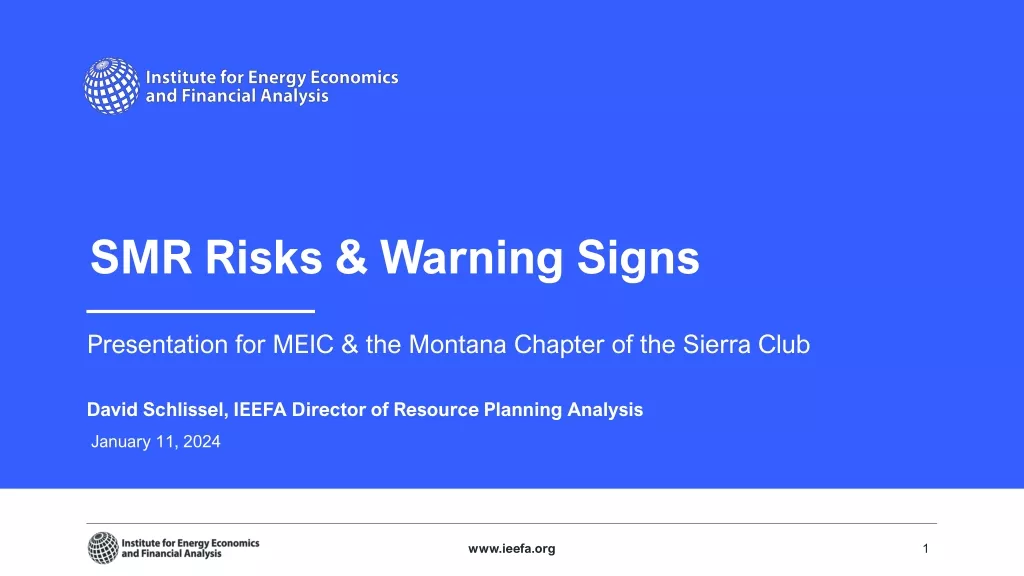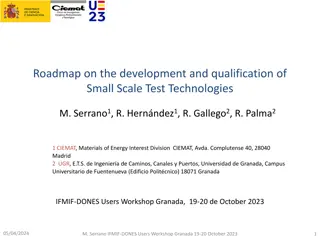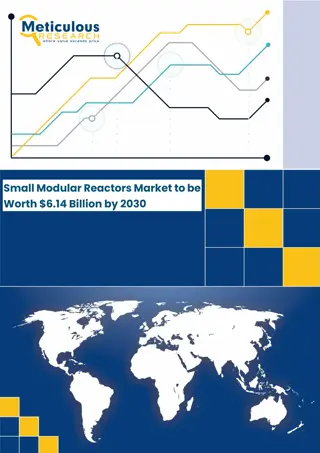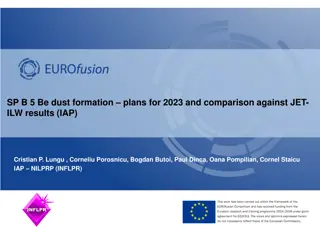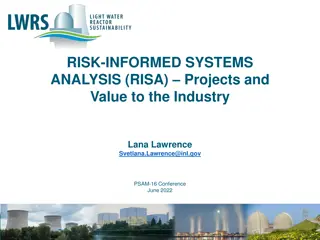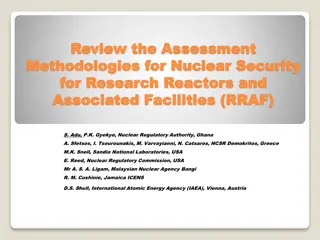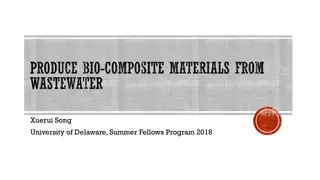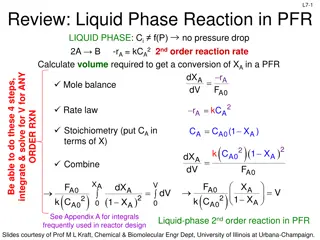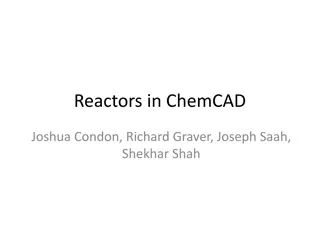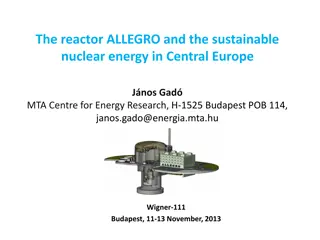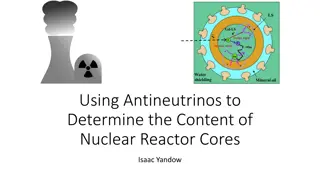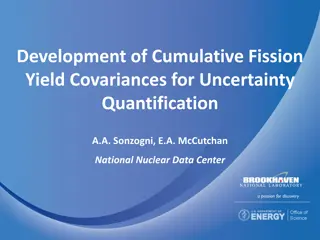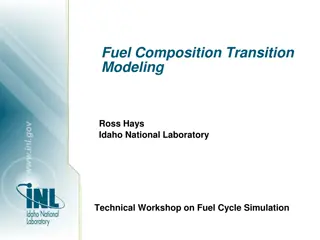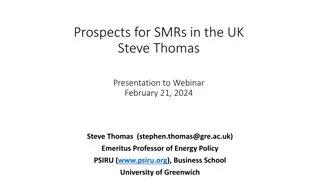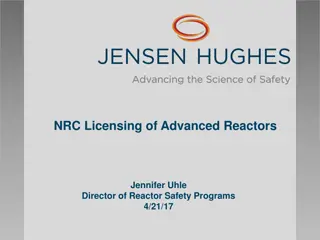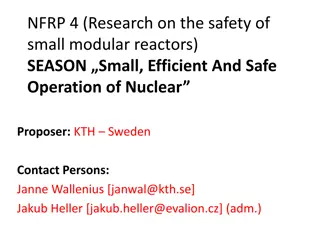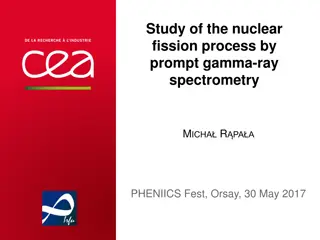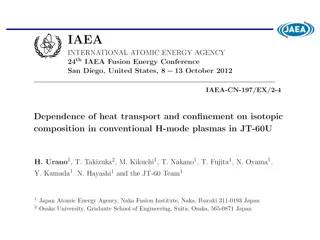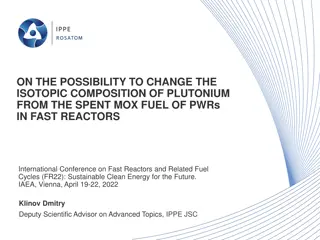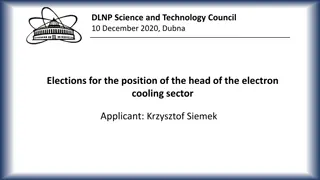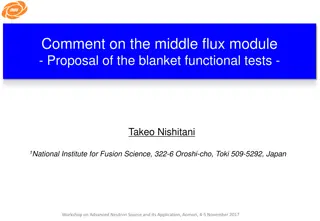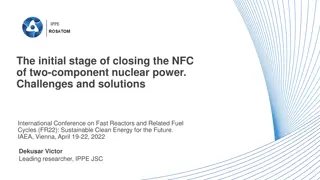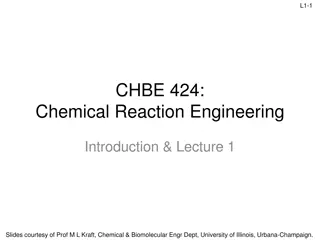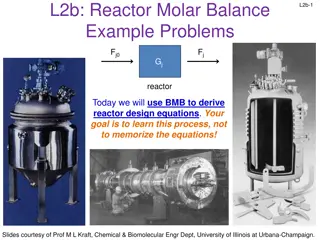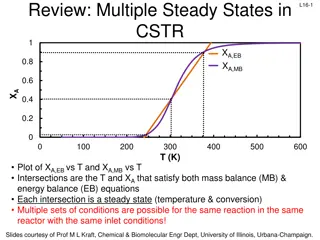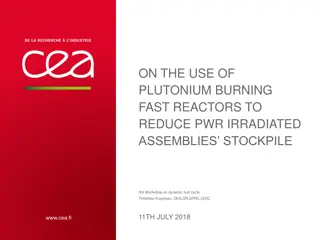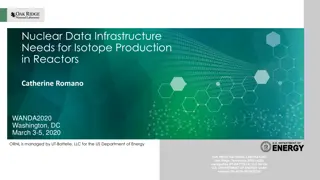Risks and Warning Signs of Small Modular Reactors (SMRs)
Small Modular Reactors (SMRs) are nuclear reactors with a power capacity of 300 megawatts or smaller. Despite potential benefits, there are significant risks associated with SMRs, including cost overruns, schedule delays, lack of construction, and high power prices. The industry's track record raise
4 views • 22 slides
Development and Qualification of Small Scale Test Technologies in Structural Engineering
Small Scale Test Technologies (SSTT) play a crucial role in determining the mechanical properties of materials used in engineering applications. This roadmap focuses on the importance of testing relevant volumes to ensure transferability to real-world structures. It discusses the need for consistent
0 views • 26 slides
Aspen Simulation of Steam Reforming and Haber-Bosch Processes in Kinetics Reactors
Aspen simulation showcases the kinetics reactors for steam reforming of natural gas and the Haber-Bosch process for ammonia production. Steam reforming is highly endothermic, producing hydrogen and CO, while the Haber-Bosch process is exothermic, crucial for ammonia synthesis. The RPlug reactor and
4 views • 26 slides
Small Modular Reactors Market by Size, Share, Forecasts, & Trends Analysis
The small modular reactors market is projected to reach $6.14 billion by 2030, at a CAGR of 2.4% during the forecast period of 2023 to 2030\n
1 views • 4 slides
Understanding Fluid Mixing in Chemical Reactions
The problems associated with fluid mixing during reactions are crucial for fast reactions in both homogeneous and heterogeneous systems. These issues involve the degree of segregation of the fluid and the timing of mixing. Concepts like RTD are intertwined with fluid mixing, affecting the behavior o
1 views • 46 slides
Investigating Be Dust Generation for Fusion Reactors
Investigate the properties of beryllium (Be) dust particles generated using milling techniques for fusion reactors. The study involves analyzing particle size, morphology, crystal orientation, and thermal behavior of Be dust in air and water environments. Laboratory experiments will be conducted to
2 views • 5 slides
Risk-Informed Systems Analysis (RISA) Projects and Value to the Industry
The Risk-Informed Systems Analysis (RISA) projects aim to optimize safety margins, minimize uncertainties, and achieve economic efficiencies while maintaining high safety levels in the nuclear industry. The projects focus on areas such as plant modernization, diversification of light-water reactors,
0 views • 10 slides
Celebrating the Legacy of Magnox Reactors at Wylfa Nuclear Power Station
Explore the rich history and contributions of Magnox reactors at Wylfa Nuclear Power Station, from their pioneering role in electricity generation to the upcoming closure of the last reactor. Join us for insightful discussions on reactor design, waste management, and the future of nuclear energy. Di
0 views • 8 slides
Reactor Sizing and Conversion in Chemical Engineering
This chapter explores the sizing of Continuous Stirred Tank Reactors (CSTR) and Plug Flow Reactors (PFR) using conversion values and overall conversion. It covers the definition of conversion, batch reactor design equations, design equations for flow reactors, and more. The content delves into the m
0 views • 17 slides
Comprehensive Review of Methodologies for Nuclear Security in Research Reactors and Facilities
This review assesses methodologies for nuclear security in Research Reactors and Associated Facilities (RRAF). It focuses on applying a performance-based framework to evaluate the protection of nuclear materials and facilities. A case study on the Vulnerability of Integrated Security Analysis method
2 views • 17 slides
Challenges in Security Analysis of Advanced Reactors
Analyzing the security aspects of advanced reactors involves considerations such as physical protection, facility sabotage, nuclear terrorism, cyber vulnerabilities, and emerging technologies. Highlighted risks include the need to protect nuclear material, insider threats, terrorist attacks causing
0 views • 8 slides
Wavelet-based Scaleograms and CNN for Anomaly Detection in Nuclear Reactors
This study utilizes wavelet-based scaleograms and a convolutional neural network (CNN) for anomaly detection in nuclear reactors. By analyzing neutron flux signals from in-core and ex-core sensors, the proposed methodology aims to identify perturbations such as fuel assembly vibrations, synchronized
3 views • 11 slides
Research on Producing Bio-Composite Materials from Wastewater Using Filamentous Bacteria and Polyhydroxyalkanoates
This project conducted at the University of Delaware aimed to evaluate the potential of using filamentous wastewater microorganisms as reinforcement and polyhydroxyalkanoates (PHA)-accumulating microorganisms as a biorenewable matrix for bio-composite materials. Filamentous bacteria were analyzed fo
1 views • 13 slides
Reactor Design Principles for Liquid and Gas-Phase Reactions
This material covers the design principles for liquid and gas-phase reactions in continuous flow reactors such as PFR (Plug Flow Reactor) and PBR (Packed Bed Reactor). It includes calculations for volume required to achieve a specific conversion, catalyst weight needed, and considerations for ideal
0 views • 21 slides
Understanding Reactors in ChemCAD: Models and Examples
ChemCAD offers various reactor models such as stoichiometric and equilibrium reactors for simulating chemical processes. Engineers can choose the appropriate model based on the reaction type and accuracy needed. Explore different reactor types through examples and process flow diagrams to enhance yo
0 views • 21 slides
Advancing Sustainable Nuclear Energy in Central Europe with Fast Reactors
Explore the potential of G4 fast reactors for advancing sustainable nuclear energy in Central Europe. Learn how fast neutron spectrum reactors can help address uranium stock depletion, waste elimination, and fuel cycle closure. Discover the regional long-term solution proposed for V4 countries and t
0 views • 12 slides
Utilizing Antineutrinos for Nuclear Reactor Core Monitoring
Plutonium can be clandestinely removed from reactors for nuclear weapons, with neutrinos emitted by reactors providing insights into core contents. Neutrino detectors require high efficiency, energy resolution, and strategic placement. Although detectors meeting these criteria exist, they are not al
1 views • 8 slides
Development of Cumulative Fission Yield Covariances for Uncertainty Quantification
This study by A.A. Sonzogni and E.A. McCutchan focuses on developing cumulative fission yield covariances for uncertainty quantification in nuclear reactors. The research involves calculating cumulative fission yields, using decay data and nuclear databases, to improve accuracy in predicting fission
0 views • 5 slides
Models for On-line Control of Polymerization Processes: A Thesis Presentation
This presentation delves into developing models for on-line control of polymerization processes, focusing on reactors for similar systems. The work aims to extend existing knowledge on semi-batch emulsion copolymerization models, with a goal of formulating models for tubular reactors. Strategies, ba
0 views • 16 slides
Fuel Composition Transition Modeling in Two-Stage Recycling Reactors
Modeling the transition of fuel composition in a two-stage recycling reactor scenario poses a unique challenge that previous versions of VISION were unable to address. By tracking fuel mass and isotopics through various stages of the fuel cycle, VISION now enables the modeling of reactors with recip
0 views • 15 slides
Insights on Small Modular Reactors (SMRs) in the UK
Steve Thomas presents an overview of Small Modular Reactors (SMRs), highlighting the challenges and misconceptions surrounding their development and commercial availability. The discussion covers various claims about SMRs, their categorization, and the current status of Advanced Modular Reactors (AM
0 views • 17 slides
NRC Licensing of Advanced Reactors and NuScale Small Modular Reactor Design Overview
Overview of NRC licensing process for advanced reactors, including a focus on Small Modular Reactors under 10 CFR Parts 50 and 52. Details on licensing options, such as Conceptual Design Assessment and Prototype Plants, are discussed. NuScale's Small Modular Reactor design, featuring passive safety
4 views • 12 slides
Overview of Chemical Reactor Design and Operation
Chemical reactor design involves studying the rates and mechanisms of chemical reactions, as well as the design of reactors for these reactions on a commercial scale. This field combines principles from thermodynamics, chemical kinetics, fluid mechanics, mass transfer, heat transfer, and economics t
0 views • 12 slides
SEASON Project: Research on Safety of Small Modular Reactors
The SEASON project led by KTH Sweden focuses on defining experiments to demonstrate compliance with safety directives for Small Modular Reactors (SMRs). It covers licensing, manufacturing, transport, operation, decommissioning, and waste management aspects. The consortium includes European SMR vendo
0 views • 4 slides
Study of Nuclear Fission Process Through Gamma-Ray Spectrometry
Delve into the nuclear fission process through prompt gamma-ray spectrometry, exploring motivations, experimental data, and preliminary results. Understand the gamma heating process in nuclear reactors and its significance in reactor safety. Contextualize the study within Generation III+ and IV reac
0 views • 86 slides
Understanding Hydrogen Isotope Influence on H-Mode Confinement in Fusion Plasmas
Knowledge of how the hydrogen isotope impacts H-mode confinement is crucial for predicting energy confinement in future fusion plasmas. Research explores the relationship between isotope mass and confinement time, highlighting the optimistic outlook for future reactors. Experimental studies on hydro
0 views • 13 slides
Introduction to Chemical Reaction Engineering (CRE)
Chemical Reaction Engineering (CRE) focuses on studying the rates and mechanisms of chemical reactions, as well as designing reactors for these reactions. The field involves understanding balances in terms of molar flow rates, mole balances, rate laws, stoichiometry, and membrane reactors. Membrane
0 views • 20 slides
Advanced Plasma Control Strategies for Fusion Reactors Weekly Meeting
Explore proposals on divertor plugging, effect of planar coil currents, Poincare maps, and main goal of loading PFCs for fusion reactors. The discussions aim to enhance plasma control strategies and optimize reactor performance.
0 views • 6 slides
Innovations in Reprocessing Spent MOX Fuel for Sustainable Nuclear Energy
Discussion at the FR22 Conference focuses on the potential for fast reactors to modify the isotopic composition of plutonium from spent MOX fuel of PWRs. By utilizing fast reactors like BN-800, countries can alter the fissile isotopes in plutonium, enabling its reuse in thermal reactors and effectiv
0 views • 8 slides
Advances in Positron Annihilation Spectroscopy and Experimental Research at DLNP Science and Technology Council Dubna
Positron annihilation spectroscopy (PAS) is a powerful technique used to study material structure and defects. DLNP Science and Technology Council in Dubna has been focusing on developing experimental techniques with slow monochromatic positron beams, leading to advancements in defect characterizati
0 views • 6 slides
Advancements in Nuclear Energy Research and Technology at UFMG
Explore the latest developments in nuclear energy research and technology at UFMG, including studies on radiation effects, nuclear waste forms, thorium reserves, and the National Institute of Science and Technology for Innovative Nuclear Reactors. The Nuclear Engineering Department at UFMG focuses o
0 views • 28 slides
Heterogeneous Transmutation of Americium in Fast Reactors: Burning for Sustainable Energy
Americium poses challenges in safe disposal due to its high radiation and volatility. However, through transmutation into other nuclides, such as 242Cm and 238Pu, it can be efficiently burned in fast reactors, offering a solution for clean energy production. Heterogeneous burning is preferred for it
0 views • 7 slides
Chemical Reactor Design: Unsteady State and Nonisothermal Reactors
Developing energy balances for unsteady state and nonisothermal reactors is essential for designing efficient chemical reactors. The energy balances involve terms such as heat flow, work done, energy accumulation, and mass flow, which impact the reactor's performance. By considering factors like pha
0 views • 29 slides
Proposal for Comprehensive Functional Testing of Blanket Modules in Fusion Reactors
The proposal discusses the need for advanced functional tests of blanket modules in fusion reactors due to the delay in the ITER program. Emphasizing the importance of early nuclear functional testing, it suggests considering partial models for assessments beyond tritium release, such as nuclear hea
0 views • 4 slides
Challenges and Solutions in Closing the NFC of Two-Component Nuclear Power
Strategic goal of transitioning Russian nuclear power plants to a two-component NES, focusing on the initial stage of closing the NFC. Scenario involves thermal neutron reactors with fuel cycle closure using BN reactors. Analysis shows the feasibility of using existing plutonium stockpiles for futur
0 views • 10 slides
Introduction to Chemical Reaction Engineering
Chemical Reaction Engineering (CRE) is crucial for understanding how chemical reactors operate in various processing operations. This field involves reactor design by integrating factors such as thermodynamics, kinetics, fluid mechanics, heat transfer, and economics. CRE aims to effectively design a
0 views • 16 slides
Reactor Design Equations: Basics and Applications
This material covers the foundational concepts of reactor design equations, focusing on molar balance in batch reactors, continuous stirred tank reactors (CSTRs), and plug flow reactors (PFRs). Through detailed explanations and illustrative examples, you will gain a comprehensive understanding of ho
0 views • 20 slides
Understanding Multiple Steady States in CSTR Reactors
This review delves into the concept of multiple steady states in Continuous Stirred Tank Reactors (CSTRs). Through a detailed analysis of mass and energy balances, intersections of temperature and conversion points are identified as steady states. The presentation discusses the implications of varyi
0 views • 25 slides
Plutonium Burning Fast Reactors for Reducing PWR Stockpile
Workshop presenting the utilization of plutonium burning fast reactors to decrease PWR irradiated assemblies stockpile through the CAPRA project. The performance and impact on plutonium inventory are assessed, highlighting the potential reduction and the additional reprocessing and manufacturing req
0 views • 16 slides
Importance of Optimizing Nuclear Data for Isotope Production in Reactors
Optimizing nuclear data is crucial for enhancing isotope production efficiency in reactors. Improved cross section data can lead to cost reductions and material savings by enabling better production optimization. Specific cross sections are required for heavy isotope production, as well as for medic
0 views • 15 slides
